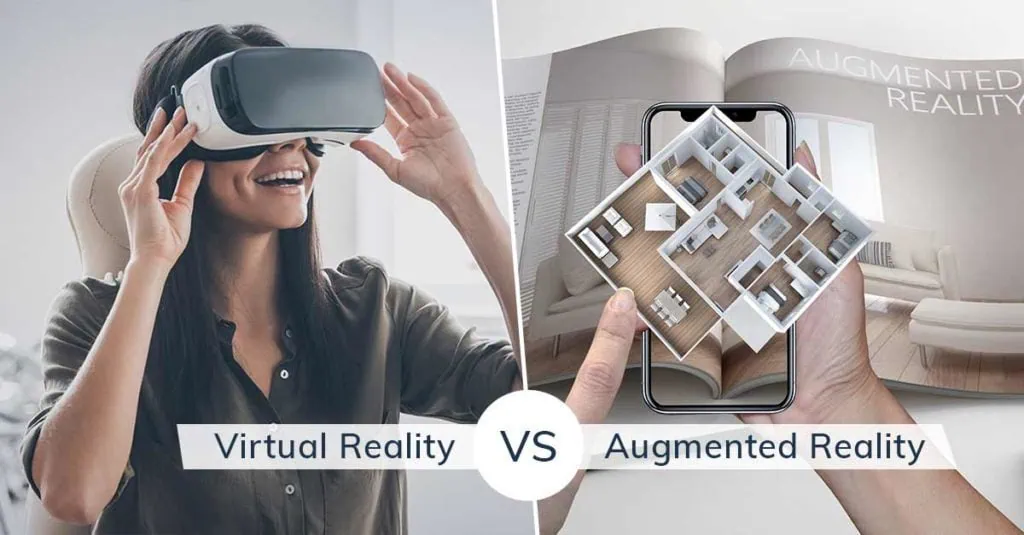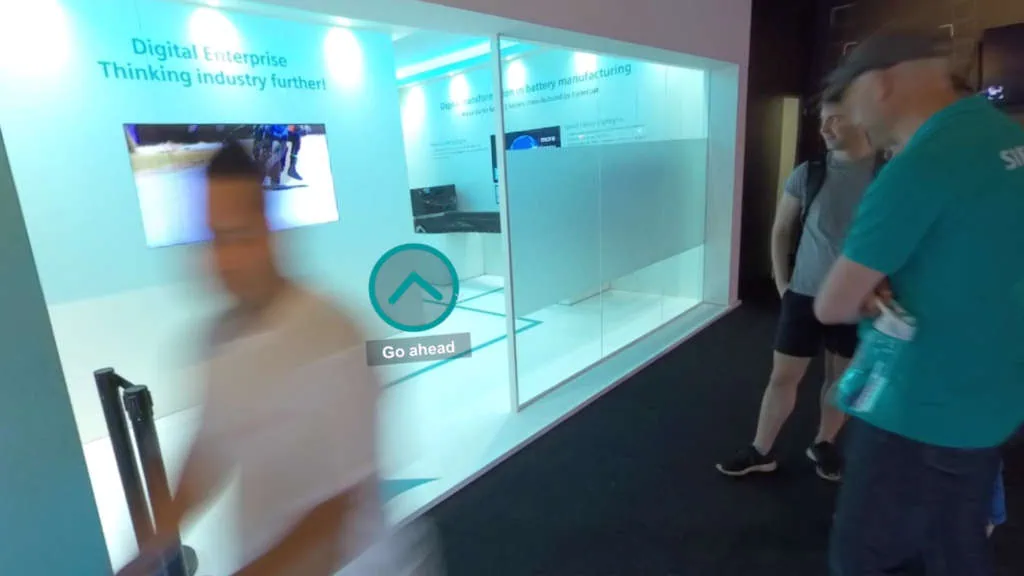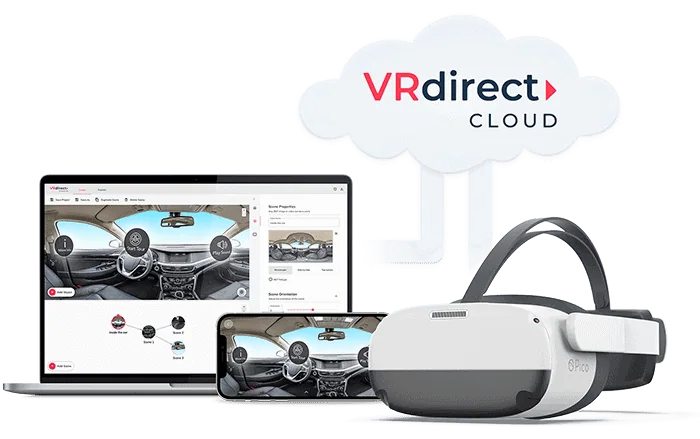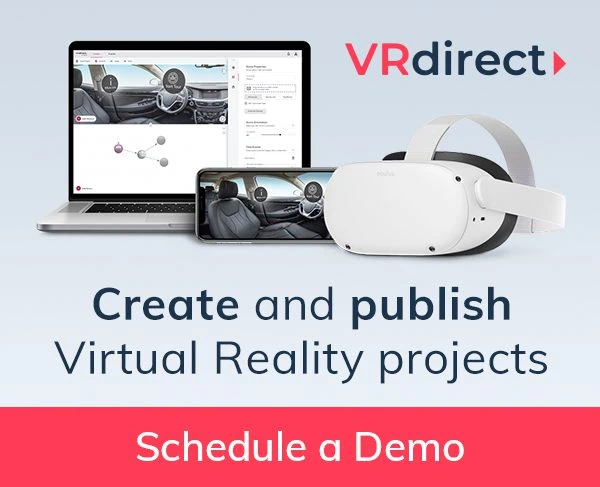At first, “Metaverse” sounds quite artificial and somewhat like a buzzword. But there is a lot of underlying substance. We explain how businesses can use VR to discover their Metaverse strategy.
What is the Metaverse?
What are Metaverse technologies?
Two technologies are fundamental to the Metaverse:
Augmented Reality integrates digital content into reality. For example, an engineer looks at a machine through an AR headset and sees digitally augmented instructions.
Virtual Reality is the second Metaverse technology—and it is well-developed and accessible. With VR headsets, people meet in virtual environments, learn in VR, train workflows, or play VR games.

VR headsets like Meta Quest 2 and Pico Neo 3 Pro are high-quality, comfortable, and affordable entry-level devices. Large companies such as Accenture use thousands of VR headsets, for example, for onboarding. Upcoming VR headsets, for instance from Apple, are getting lighter and more comfortable.
Filmed or photographed 360° content for VR headsets is particularly effective because it is photorealistic yet interactive, runs on most devices—including browsers and smartphones—and can be produced quickly and easily.
What are the advantages of VR as a Metaverse technology?
Virtual Reality has many advantages. People concentrate completely on a subject in VR because it doesn’t allow any distractions.
Additionally, our brain perceives Virtual Reality spatially – like reality. For example, it remembers individual work steps during a training session better than on a standard monitor. Controlling the direction of our gaze in VR through head movements also stimulates our muscle memory.
These and other benefits of VR take effect in all use cases where audiovisual components and motion come into play. Other examples include advertising, training, presentations, pitches, virtual tours and so on.
How does Virtual Reality help businesses?
Since VR is now available anytime and anywhere, employees can build routines for work steps that they cannot train in reality at all, or only rarely, or at expensive prices. They can learn faster and more flexibly and remember the information better. This also applies to training or onboarding.
Additionally, VR is for the remote age: people meet virtually and have a feeling of being close to each other in virtual space, despite the physical distance. This has a particularly positive effect on all sorts of meetings.
Marketers find the perfect creative playground in VR: from interactive 360 product presentations to distraction-free learning trips through the inner mechanics of a machine directly at the trade show booth. VR offers a fantastic canvas for unusual advertising ideas with high persuasive power.
Companies can save money with VR, for example by shortening onboarding and training times, or they generate more sales by using more convincing advertising. They also expand their remote offerings—an important factor in finding and retaining talent. VRdirect customers like Siemens are already successfully using VR for presentations, training, education and in other sectors.

How does Virtual Reality introduce businesses into the Metaverse?
Virtual Reality is the gateway into the Metaverse: It is available today, well-developed, affordable and can be used flexibly in numerous use cases.
Companies that start using VR now are planning their processes for the Metaverse and using VR content to familiarize their employees with the new digital age. This also makes them much more attractive to Gen Z talent.
Just remember: the Metaverse is also a moment in time. And when that time comes, VR-savvy companies will already be Metaverse-ready—just like companies that had their first website online before the big Internet boom.
Conclusion: Metaverse strategy? Learning by doing!
The best time to get started with Metaverse VR technology is right now. The use cases are highly sophisticated and offer proven perks for work and production processes, onboarding, employer positioning, education, training, quality management and many other areas.
At the same time, VR still offers ample scope for development and design until the Metaverse really takes off as the new Internet.
Businesses starting with VR today are therefore doing everything right: they create real benefits in everyday work and at the same time provide inspiration for the Metaverse future, gather experience, and establish processes.
Everything else will come along the way. Companies can use the following points to guide their Metaverse strategy.
Guide: How companies get into the metaverse with VR step by step
1. Identify use cases for VR in your company. Many companies get started with pilot projects in training and onboarding, or with unconventional marketing ideas. Here, VR can be implemented quickly and offers significant added value.
2. Start by determining how you want to use VR to improve the selected use case and what could be a measurable goal.
3. It is important that the department where VR will be used is committed and passionate. Get the colleagues involved, for example with good examples or a demo! Establish a “Metaverse mindset” strategically in the company’s DNA.
4. Look for experts who have a lot of experience with VR to help you with this process.
5. Now it’s time for the content concept: With which content can you achieve the goals you have set before?
6. Together with the experts, select the right VR headset and the appropriate content format—for example, interactive scenes with images, videos, or animations. Depending on task and goal, there are numerous options.
7. Use the experience, data, and feedback from the pilot project to plan and improve the next VR projects. The technology evolves along your processes.
That's how you make your business Metaverse-ready, step by step.
Your experts for starting into the Metaverse: VRdirect
VRdirect helps companies master Virtual Reality. We accompany them strategically on their way into the Metaverse. Training, education, presentation, marketing: As VR professionals, we have successfully realized many Virtual Reality projects with several top companies over the past years.
We offer a free initial consultation on how to get started with VR and the Metaverse. We will gladly send you a state-of-the-art VR headset including free demos—or you can visit our showroom and see for yourself.






